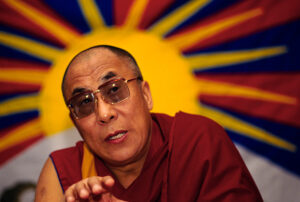One of the most arresting images from Narendra Modi’s first term in office as India’s Prime Minister dates from 21st June 2015. He is kneeling on a yoga mat laid out on Rajpath, New Delhi’s great ceremonial boulevard. Behind him, stretching all the way back to India Gate in the far, foggy distance, are some 35,000 people sat on yoga mats of their own. It is a remarkable metaphor of national leadership: a prime minister guiding his people through a series of health-giving bends and stretches. There was even a new Guinness world record into the bargain, for the largest ever yoga session.
Modi had been angling for a moment like this since September of the year before, when he lobbied the United Nations to make 21st June “International Yoga Day”. In an address to the General Assembly, he claimed that “Yoga is an invaluable gift from our ancient tradition. Yoga embodies unity of mind and body, thought and action … a holistic approach [that] is valuable to our health and our well-being. Yoga is not just about exercise; it is a way to discover the sense of oneness with yourself, the world and nature.”
Modi’s successful pitch for yoga at the UN contained eerie echoes of a pitch for Hinduism made by one of his heroes, the religious teacher Swami Vivekānanda, to the World’s Parliament of Religions in Chicago back in 1893. It was a masterclass in using the language of inclusivity to make the case for a particular idea. Hinduism, declared Vivekānanda, is the “mother of all religions” and has “taught the world both tolerance and universal acceptance”. To an audience consisting primarily of American Christians, familiar with Jesus’s claim that “No one comes to the Father except through me”, Vivekānanda offered a contrasting line from the Bhagavad Gita: “Whosoever comes to Me, through whatsoever form, I reach him; all men are struggling through paths which in the end lead to me.”
Vivekānanda’s expansive case for Hinduism was helped by the fact that the concept itself was only around a century old by the late 1800s and remained somewhat flexible. Europeans in colonial-era India had used the term “Hindu” (derived from a Sanskrit word for the Indus River) to describe people on the subcontinent who did not belong to better-understood and apparently more clearly-defined traditions such as Christianity, Judaism and Islam. Indian reformers later used the term “Hinduism” to refer to a broad system of ideas and practices that went beyond “religion” in the narrow confessional sense familiar to modern Westerners and encompassed culture, identity and, in time, a sense of national political purpose.
In the decades running up to Indian independence in 1947, there was nervousness among religious minorities — particularly Muslims — about what this might mean for the role played by Hinduism in a future independent India. The country’s first Prime Minister, Jawaharlal Nehru, was among those who advocated for secularism and religious pluralism. Other forces in Indian politics, including the predecessor to Modi’s Bharatiya Janata Party (BJP), encouraged the idea that India is fundamentally a Hindu country and that its politics and institutions ought to reflect that fact.
The vexed politics of “Hinduism” in India — religious tradition versus a more encompassing cultural or national identity — has been mirrored in the West by arguments about yoga, one of whose earliest teachers was Swami Vivekānanda during visits to the United States. Is yoga essentially religious in character? If so, is it wrong to use it purely for its health benefits or to teach it in schools that are subject to rules about the separation of church and state? And given its origins in India, is there something morally wrong or at least a little unseemly about white Westerners making money from promoting it — or even practising it at all?
Just as these anxieties appear to be ebbing in the West — though concerns remain about shallow and overly-commercialised forms of yoga — Modi has been leading the charge to reclaim yoga for Indians, and for himself in particular. It is part of a broader push to promote traditional Indian culture at home and to leverage India’s spiritual wealth abroad as a soft power asset. Modi has already made much of his country as the home of Buddhism, finding it useful when dealing with Buddhist-influenced cultures around Asia, from Vietnam to Korea.
Modi’s critics worry about what this might mean for the secular and pluralist character of their democracy. When, in his 2014 speech to the UN General Assembly, Modi described yoga as a gift from “our ancient tradition”, who exactly was the implied “we”? Indians as a whole — or the country’s large Hindu majority? Modi and the BJP are suspected of using yoga as a means of encouraging people, both at home in India and abroad, to think of those two categories as more or less one and the same. That risks reinforcing the idea that India’s Muslims, Christians and Dalits — formerly referred to as “untouchables” and historically mistreated by upper-caste Hindus — are outsiders, potentially exposing them to yet more discrimination and violence. Modi is also accused of engaging in what one commentator memorably called “om-washing”: linking yoga to everything from world peace to a healthier climate while pursuing destructive policies on these and other issues.
No doubt there will be those who regard worries over Modi’s appropriation of yoga as of no more consequence than hand-wringing in the West about wellness enthusiasts who like to greet each other with namaste gestures. Depending on your point of view, Indian soldiers performing yoga in freezing temperatures at the Siachen Glacier is either a step towards entrenching Hindu nationalism at the heart of Indian politics while provoking Pakistan — with whom India remains in dispute over sovereignty in the region — or simply a nice touch for International Yoga Day. Likewise, government bureaucrats and foreign diplomats in India taking up yoga, on Modi’s advice, may be regarded either as working on their general health or participating in a slow but steady narrowing of acceptable discourse in India.
Time will tell just how much or little this matters for India. As Modi enters his third term as prime minister, the argument over yoga seems set to extend to schools across the country. Some BJP-led regional administrations have already sought to make it mandatory among the nation’s children, prompting objections from defenders of India’s minorities and the country’s secular constitution. A Sun Salutation — or Surya Namaskar — may strike most as an innocent sequence of yoga moves. But “Surya” is both the sun and the Hindu solar deity, rendering the sequence controversial in the eyes of some Muslim groups in India.
Those wanting to see yoga’s influence diminished in Indian politics may hope that Modi’s Olympic dream comes true. Modi wants the Games to come to India in 2036, and for yoga to be included on the list of events alongside chess, kabaddi, kho kho, squash and T20 cricket. It may well prove divisive: plenty of yoga practitioners will no doubt object to what they see on display, just as large numbers of karate fans regarded its Olympic incarnation — when Tokyo hosted a delayed Games in 2021 — as “not proper karate”. A more potent message still would be sent if things take an Australian turn. The sight of an unfortunate competitor butchering their contribution — offering an unintentionally comic twist on the downward dog to rival Raygun’s kangaroo hop — might end up harming yoga’s global reputation.
In the shorter term, there seems little prospect that Modi will retire yoga as a pawn in India’s over-heated politics. Promoting ancient glories is a cheaper and more reliable way of winning hearts and minds than promising the earth politically, whether at home or abroad. And as long as the wellness boom is with us, so too will be that sweet spot where fitness, fulfilment and wisdom coincide — seasoned, dare it be said, with a dash of the exotic, courtesy of images of the far-away or the long-ago. For all the anxieties that it seems to be causing of late, in the West and in India, nothing promises to hit that spot quite like a good sweaty hour on a yoga mat.
Disclaimer
Some of the posts we share are controversial and we do not necessarily agree with them in the whole extend. Sometimes we agree with the content or part of it but we do not agree with the narration or language. Nevertheless we find them somehow interesting, valuable and/or informative or we share them, because we strongly believe in freedom of speech, free press and journalism. We strongly encourage you to have a critical approach to all the content, do your own research and analysis to build your own opinion.
We would be glad to have your feedback.
Source: UnHerd Read the original article here: https://unherd.com/




